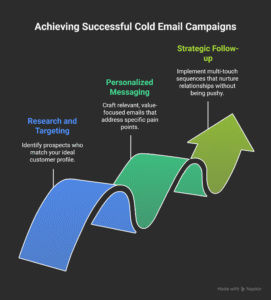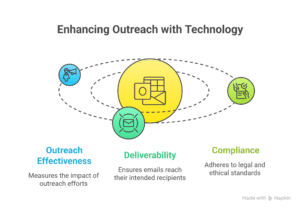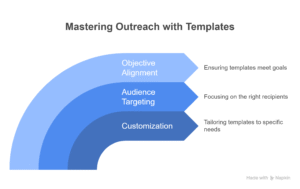Master the art of cold email outreach in 2025 with proven strategies, compliance-ready templates, and cutting-edge tools that generate real results. This comprehensive guide provides everything you need to build meaningful business relationships and drive conversions through strategic email communication.
Cold email remains one of the most powerful business growth tools available today. While the landscape has evolved significantly, businesses using strategic cold email campaigns report an average ROI of 4,400% according to recent data from Campaign Monitor. However, success requires more than sending bulk messages to random prospects.
This guide reveals the exact strategies, tools, and templates that top performers use to achieve response rates exceeding 15%. You’ll discover compliance requirements, proven personalization techniques, and actionable tactics that transform cold outreach into warm conversations.
What is Cold Email Outreach
Cold email outreach involves sending targeted, personalized messages to prospects who haven’t previously interacted with your business. Unlike spam, effective cold email provides genuine value while respecting recipient preferences and legal requirements.
The fundamental difference between successful cold email and ineffective spam lies in relevance and personalization. Modern prospects expect messages that demonstrate research, understanding, and clear value propositions tailored to their specific needs.
How Strategic Cold Email Works

Successful cold email campaigns follow a systematic three-phase approach:
- Research and targeting: Identify prospects who match your ideal customer profile and would genuinely benefit from your offering
- Personalized messaging: Craft relevant, value-focused emails that address specific pain points or opportunities
- Strategic follow-up: Implement multi-touch sequences that nurture relationships without being pushy
Why Cold Email Delivers Results in 2025
Despite increasing digital noise, cold email continues to outperform many other outreach methods:
- Direct access: Email provides unfiltered access to decision-makers’ most personal digital space
- Cost efficiency: Cold email costs 40 times less than traditional advertising while delivering comparable conversion rates
- Relationship building: Unlike ads, cold email initiates genuine two-way conversations that build trust
- Scalable personalization: Modern tools enable personalized outreach at scale without sacrificing quality
Legal Compliance and Best Practices for 2025
Understanding compliance requirements protects your business while building recipient trust. Cold email remains completely legal when executed properly, but violations can result in significant penalties.
Key Global Regulations
Different regions have specific requirements that affect cold email campaigns:
- GDPR (European Union): Requires legitimate business interest and clear opt-out mechanisms. Violations can result in fines up to 4% of annual revenue
- CAN-SPAM (United States): Mandates truthful subject lines, sender identification, and easy unsubscribe options. Maximum penalty of $51,744 per violation
- CASL (Canada): Strictest global requirements, often requiring explicit consent. Business fines can reach $10 million
Universal Compliance Requirements
Follow these essential practices to ensure legal compliance across all jurisdictions:
- Clear sender identification: Always identify yourself and your company truthfully
- Legitimate business interest: Only contact prospects with logical business reasons
- Easy opt-out mechanism: Include functional unsubscribe links in every email
- Physical address: Provide your business address in email footers
- Immediate unsubscribe processing: Honor removal requests within 10 business days
Building a High-Converting Cold Email Strategy
Successful cold email campaigns require systematic planning and execution. This proven framework consistently generates response rates above industry averages.
Step 1: Define Clear Campaign Objectives
Specific goals shape every aspect of your campaign strategy. Common objectives include:
- Lead generation: Schedule qualified sales conversations
- Partnership development: Establish strategic business relationships
- Content promotion: Increase content visibility and engagement
- Talent acquisition: Attract qualified candidates
- Link building: Earn high-quality backlinks for SEO
Step 2: Create Hyper-Targeted Prospect Lists
Quality targeting dramatically improves response rates. Highly targeted campaigns generate 67% higher conversion rates than broad outreach efforts according to Marketing Sherpa research.
Develop detailed prospect profiles including:
- Demographics: Job titles, company size, industry verticals, geographic location
- Behavioral triggers: Recent funding, leadership changes, product launches, growth indicators
- Technology stack: Current tools and platforms they use
- Pain points: Specific challenges your solution addresses
Recommended prospecting tools for 2025:
- Apollo.io: Comprehensive B2B database with advanced filtering and email verification
- LinkedIn Sales Navigator: Leverage professional networks and trigger events
- ZoomInfo: Enterprise-level prospect intelligence and company insights
- Hunter.io: Email finder with domain search and verification capabilities
Step 3: Craft Compelling, Personalized Messages
Your email must accomplish three critical objectives within the first few seconds:
- Capture attention with relevant, specific subject lines
- Establish credibility and demonstrate research
- Present clear, valuable propositions
Follow this proven email structure:
- Subject line: Specific, curiosity-inducing, under 50 characters
- Opening hook: Personal connection or relevant observation
- Context establishment: Brief introduction explaining your outreach reason
- Value proposition: Clear benefit or solution you provide
- Specific call-to-action: Single, clear next step request
- Professional closing: Friendly but respectful sign-off
Step 4: Optimize Timing and Delivery
Timing significantly impacts open and response rates. Emails sent on Tuesday through Thursday between 8-10 AM generate 23% higher open rates than other time periods.
Best practices for timing optimization:
- Time zone consideration: Send emails in recipient’s local business hours
- Industry-specific timing: Adjust for target audience schedules and preferences
- Mobile optimization: Ensure emails display properly on mobile devices
- Frequency management: Space emails appropriately to avoid overwhelming prospects
Step 5: Implement Strategic Follow-Up Sequences
Most successful conversions occur after multiple touchpoints. Research shows 80% of cold email conversions happen after the fifth follow-up, yet most people stop after two attempts.
Effective follow-up sequence structure:
- Follow-up 1 (3-4 days): Gentle reminder with additional value or social proof
- Follow-up 2 (1 week): Different angle or case study demonstrating results
- Follow-up 3 (2 weeks): Resource sharing or industry insight
- Follow-up 4 (3-4 weeks): Final attempt with clear end date
Essential Tools for Modern Cold Email Success

The right technology stack amplifies your outreach effectiveness while maintaining deliverability and compliance. Here are the top-performing tools for 2025.
All-in-One Outreach Platforms
- Instantly.ai: Advanced deliverability features with automated warm-up and domain rotation
- Smartlead: Multi-inbox management with built-in deliverability protection
- Lemlist: Creative personalization including custom images and videos
- Apollo.io: Complete sales stack combining prospecting, outreach, and CRM functionality
Specialized Email Tools
- Mailreach: Automated email warm-up service improving sender reputation
- Hunter.io: Email finder and verification with high accuracy rates
- Clearbit: Data enrichment for enhanced prospect information
- GlockApps: Comprehensive deliverability testing and monitoring
AI-Powered Personalization Tools
Artificial intelligence is revolutionizing cold email personalization at scale:
- Clay: Intelligent data gathering and personalization automation
- Lavender.ai: AI email coach providing real-time optimization suggestions
- SmartWriter: Automated personalization based on prospect social media activity
- Regie.ai: AI-powered content generation for sales sequences
Proven High-Converting Email Templates

These battle-tested templates provide frameworks for various outreach scenarios. Customize each template based on your specific audience and objectives.
B2B Software Sales Template
Subject: Quick question about [company name]'s [specific process]
Hi [Name], Noticed [company name] recently [specific trigger event]. Congrats on the [achievement/growth/launch]! I help [similar companies] reduce [specific pain point] by [percentage/timeframe]. For example, [Company X] saved 15 hours weekly using our [solution type]. Worth a 15-minute conversation to see if this applies to [company name]? Best regards, [Your name]
Link Building Outreach Template
Subject: Resource for your [specific article title]
Hi [Name], Your article on [specific topic] provided excellent insights on [specific point]. Your section about [detail] particularly resonated with our experience. I recently published comprehensive research on [related topic] that includes [specific data/insight not covered in their article]. Thought it might add value for your readers. Here's the resource: [URL] No worries if it's not a fit—just wanted to share. Best, [Your name]
Partnership Development Template
Subject: Partnership opportunity - [mutual benefit]
Hi [Name], Impressed by [company name]'s work in [specific area]. Your approach to [specific strategy] aligns perfectly with what we're seeing in the market. We help [target audience] achieve [specific outcome]. There might be opportunity for our companies to collaborate on [specific area/project]. Interested in exploring this further? Happy to share some initial ideas. Looking forward to hearing from you, [Your name]
Template Customization Best Practices
- Research thoroughly: Spend 5-10 minutes researching each prospect before personalizing
- Reference specific details: Mention recent company news, social media posts, or mutual connections
- Match communication style: Adapt formality level to company culture and industry norms
- Include relevant social proof: Use specific metrics and client examples when appropriate
- Keep it concise: Aim for 75-125 words maximum for optimal response rates
Measuring and Optimizing Cold Email Performance
Data-driven optimization separates successful campaigns from mediocre ones. Track these essential metrics to continuously improve your results.
Essential Performance Metrics
Primary KPIs:
- Open Rate (Target: 45%+): Indicates subject line effectiveness and sender reputation
- Reply Rate (Target: 10-15%): Most critical metric for cold email success
- Conversion Rate (Target: 3-7%): Percentage completing desired actions
- Positive Response Rate: Quality of engagement and interest level
Secondary Metrics:
- Click-through Rate: Engagement with links and resources
- Unsubscribe Rate (Target: <1%): Audience targeting accuracy
- Bounce Rate (Target: <3%): Email list quality and deliverability
- Time to Response: Message urgency and relevance indicators
A/B Testing Strategies
Systematic testing drives continuous improvement. Focus on these high-impact variables:
- Subject lines: Test different formats, lengths, and personalization approaches
- Opening lines: Compare personal connections versus direct value propositions
- Call-to-actions: Test specific versus open-ended requests
- Email length: Compare concise versus detailed approaches
- Send timing: Optimize days and times for your specific audience
Industry-Specific Cold Email Strategies
Different industries require tailored approaches that respect unique cultures, challenges, and communication preferences.
Technology and SaaS
Tech prospects value efficiency, data, and innovation. Focus on:
- Quantifiable benefits: Specific metrics and ROI calculations
- Technical credibility: Demonstrate understanding of their tech stack
- Integration capabilities: Show how your solution fits their ecosystem
- Scalability discussion: Address growth and future needs
Healthcare and Medical
Healthcare professionals prioritize patient outcomes and regulatory compliance:
- Patient benefit focus: Emphasize improved care outcomes
- Compliance assurance: Address regulatory requirements upfront
- Evidence-based results: Include clinical data and peer-reviewed research
- Time sensitivity: Respect demanding schedules with concise communication
Financial Services
Financial professionals value risk mitigation and proven results:
- Risk assessment: Address security and compliance concerns
- ROI demonstration: Provide clear financial justification
- Regulatory compliance: Show understanding of industry regulations
- Conservative approach: Use professional, formal communication style
Emerging Trends in Cold Email for 2025
Stay ahead of the competition by understanding these key trends shaping cold email success.
AI-Enhanced Personalization
Artificial intelligence enables unprecedented personalization scale. Companies using AI personalization report 41% higher response rates compared to traditional approaches.
Key AI applications include:
- Dynamic content generation: AI creates unique messages based on prospect data
- Sentiment analysis: Tools analyze prospect communication preferences
- Optimal timing prediction: AI determines best sending times for individual prospects
- Follow-up optimization: Automated sequence adjustments based on engagement patterns
Multi-Channel Integration
Successful outreach increasingly combines email with other channels:
- LinkedIn + Email sequences: Coordinated social and email touchpoints
- Video personalization: Custom video messages increasing engagement
- Direct mail integration: Physical and digital channel coordination
- Retargeting alignment: Email outreach supported by targeted advertising
Advanced Deliverability Management
Email providers continue tightening filtering algorithms. Successful campaigns require:
- Domain warming protocols: Gradual reputation building for new domains
- Inbox rotation strategies: Multiple sending addresses to distribute volume
- Engagement monitoring: Real-time deliverability tracking and optimization
- Authentication compliance: Proper SPF, DKIM, and DMARC configuration
Common Cold Email Mistakes to Avoid
Understanding common pitfalls prevents costly errors and reputation damage.
Critical Mistakes
- Generic messaging: Sending identical emails to different prospects
- Weak subject lines: Vague or misleading subject lines reducing open rates
- Pushy follow-ups: Aggressive or frequent follow-up messages
- Poor list quality: Outdated or inaccurate contact information
- Compliance oversights: Missing unsubscribe links or sender identification
- Mobile neglect: Emails not optimized for mobile viewing
Best Practice Reminders
- Always provide value: Every email should offer something beneficial
- Respect unsubscribe requests: Honor opt-outs immediately and completely
- Monitor sender reputation: Track deliverability metrics consistently
- Test before scaling: Validate approaches with small groups first
- Maintain professional tone: Balance friendliness with business appropriateness
Frequently Asked Questions
What’s the ideal cold email length?
Optimal cold emails contain 75-125 words. Emails in this range generate 27% higher response rates than longer messages while providing sufficient context and value.
How many follow-ups should I send?
Send 3-4 strategic follow-ups spaced 3-7 days apart. Each follow-up should provide new value rather than simply repeating your original message. Stop if prospects explicitly request no further contact.
What’s a good response rate for cold email?
Industry benchmarks suggest 8-12% response rates for well-executed campaigns. However, highly targeted campaigns with strong personalization can achieve 15-25% response rates.
Should I include attachments in cold emails?
Avoid attachments in initial cold emails as they trigger spam filters and security concerns. Instead, include links to hosted resources or offer to send materials upon request.
How do I improve email deliverability?
Maintain deliverability through proper email authentication, gradual volume increases, high-quality prospect lists, engaging content that generates positive responses, and consistent monitoring of bounce and spam complaint rates.
Conclusion
Cold email remains a powerful business development tool when executed strategically. Success requires combining compliance knowledge, targeted prospecting, personalized messaging, and continuous optimization based on performance data.
The strategies, templates, and tools outlined in this guide provide everything needed to build effective cold email campaigns. Start with thorough prospect research, craft compelling personalized messages, and maintain consistent follow-up sequences while respecting recipient preferences.
Remember that cold email success comes from building genuine relationships and providing real value. Focus on solving prospect problems rather than pushing products, and your outreach efforts will generate meaningful business results.


